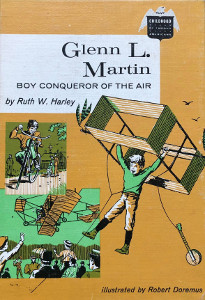Glenn L. Martin: Boy Conqueror of the Air

Author:
Ruth W. Harley
Illustrator:
Robert Doremus
Publication:
1967 by Bobbs-Merrill Company
Genre:
Biography, Non-fiction
Series:
Childhood of Famous Americans
Pages:
200
Current state:
This book has been evaluated and information added. It has not been read and content considerations may not be complete.
Book Guide
Search for this book used on:
Glenn L. Martin was born in 1886 in Macksburg, Iowa, but spent most of his early boyhood in Liberal, Kansas. Liberal was located in the heart of a farming country near the eastern edge of the Great Plains. It was still a sort of frontier community, where the people frequently engaged in cattle drives and buffalo hunts.
Glenn was an enterprising and inquisitive boy, a good student in school, but a boy with many interests outside of school. He was greatly interested in machines, eager to examine and understand them. He was curious about kites and the flight of birds, and he felt that somehow men should find a way to fly through the air. So far they could only fly with balloons.
In Liberal, Glenn's father ran a hardware store and farmed on the side. One summer when the weather destroyed his wheat crop, he sold his hardware store and moved to Salina, Kansas. By now Glenn had broadened his interest in flying and was carefully studying the experiments of men who were working with gliders. For the time being he devoted most of his attention to automobiles and obtained a position as a mechanic.
In 1908 the family moved from Kansas to Santa Ana, California. Here young Martin set up an automobile agency and a garage. His interest in flying had become intensified by the recent experiences of Wilbur and Orville Wright in flying the first airplane.
Young Martin had never seen an airplane, but he was determined to build one. Finally, in 1909, he completed and flew his first airplane. Soon he began to make exhibition flights and within a few years started to manufacture airplanes for sale. By the time of World War I, he was one of the leading airplane manufacturers in America.
During the 1920's and 1930's Martin greatly expanded his airplane activities. He designed and manufactured massive bombers and developed great flying boats, such as the China Clippers. During World War II, his bombers and other aircraft played a major part in winning victory for the Allies.
Following the war, Martin began to give particular attention to rocketry. He sensed a change in aviation needs and began to build machinery for the exploration of space. During his lifetime he made the full journey from flying kites in his pioneer days to manufacturing the needed "hardware" for the advent of the present Space Age.
From the dust jacket
To view an example page please sign in.
Content Guide
Please sign in to access all of the topics associated with this book and view other books with the same topics.
Please sign in to access the locations this book takes place in and view other books in the same location.
Please sign in to access the time periods this book takes place in and view other books in the same time period.
For information about the lead characters please sign in.
Find This Book
Search for this book used on:


